Organizational Change towards Greater Sustainability Assignment. https://studentshare.org/human-resources/1775462-organizational-change-towards-greater-sustainability
Organizational Change towards Greater Sustainability Assignment. https://studentshare.org/human-resources/1775462-organizational-change-towards-greater-sustainability.


